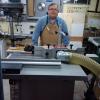This question is mostly for woodworkers in metric lands, especially Australia and the UK. How available are 1/2", 3/8", and 1/4" router bits for you?
In converting imperial measurements to metric for woodworking plan do I typically round to nearest mm? Can you buy supplies from Mcmaster Carr?...or if not, is there a comprehensive industrial supplier you use?
Thanks!




 Reply With Quote
Reply With Quote




